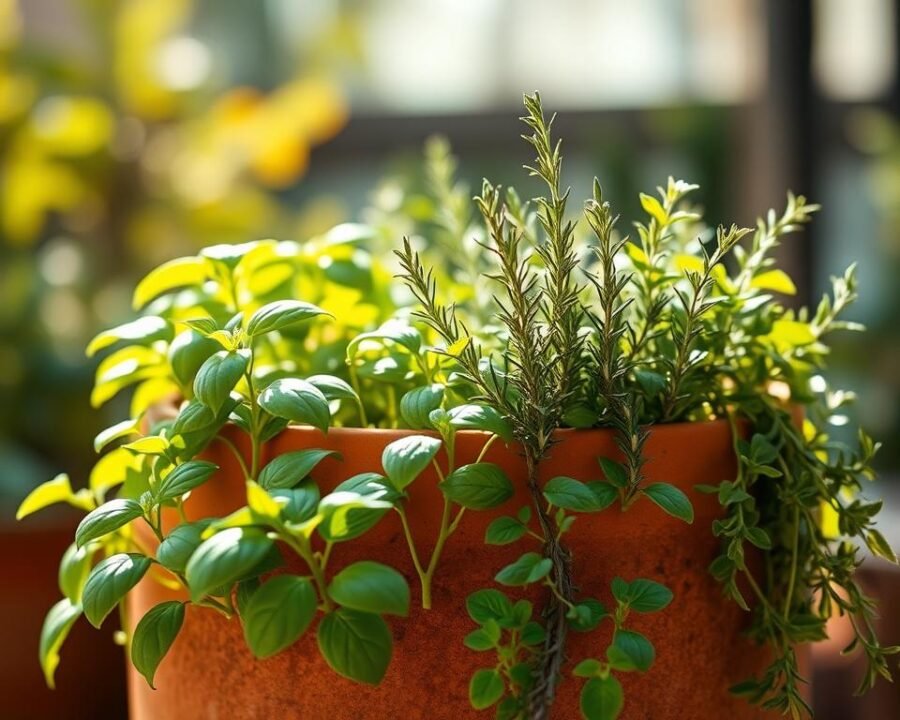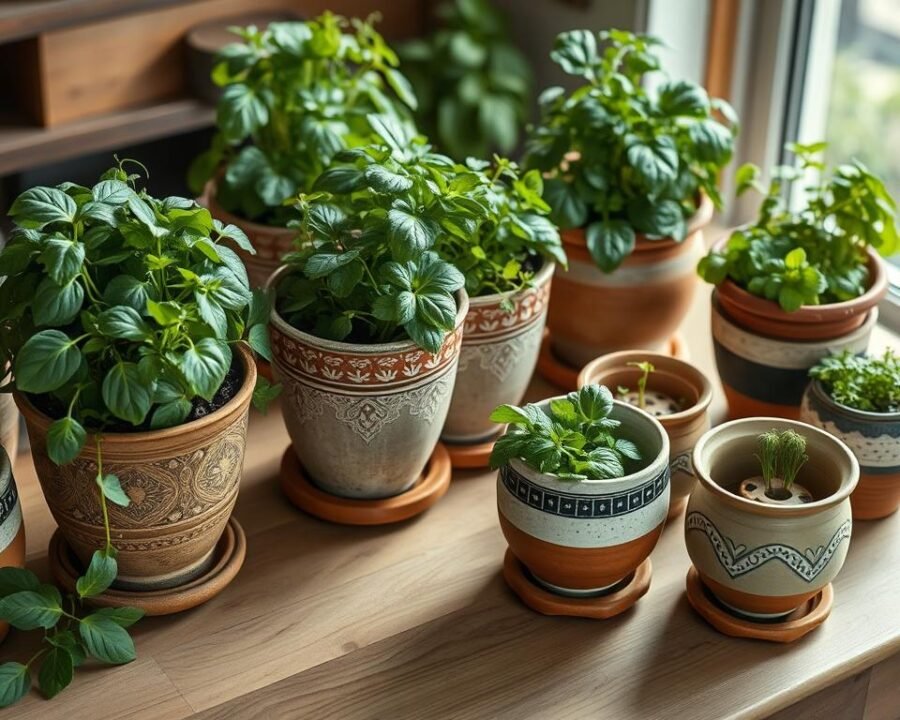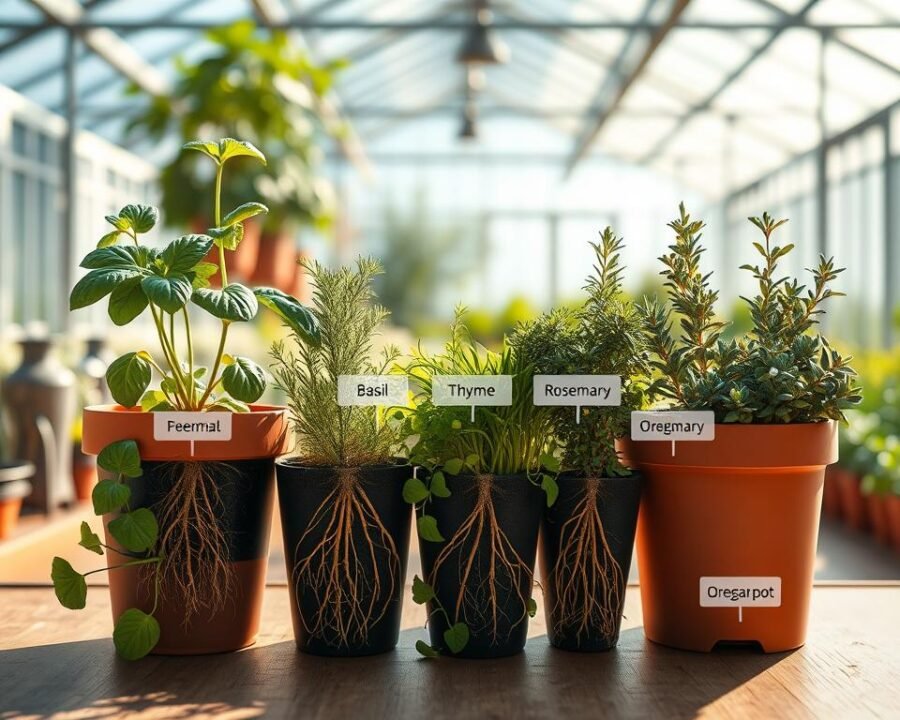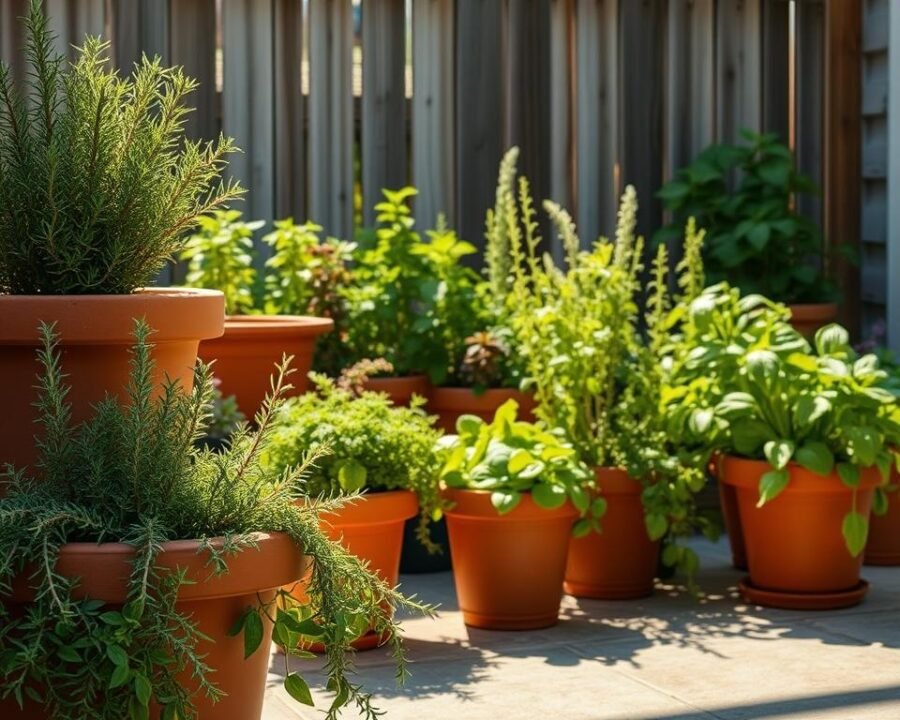Discover the Best Potted Herb Garden You Need to Try
There’s something magical about snipping fresh herbs right before cooking. The aroma fills the air, and the flavors transform ordinary meals into something special. Whether you live in a tiny apartment or have a sunny balcony, growing your own herb garden is easier than you think.
No more wilted store-bought bundles or last-minute grocery runs. With a simple container and a little care, you can cultivate a thriving collection of basil, mint, or chives. Even beginners find success with low-maintenance options like rosemary or thyme.
Urban dwellers love the flexibility of small-space gardening. Imagine stepping outside to harvest parsley for dinner or garnishing drinks with homegrown mint. It’s a small luxury that reconnects us to tradition and fresh, vibrant flavors.
Key Takeaways
- Fresh herbs elevate meals with unmatched flavor and aroma.
- Container gardening works perfectly in apartments or small spaces.
- Low-effort varieties like chives are ideal for beginners.
- Growing at home cuts down on grocery store trips.
- Urban spaces can thrive with the right plant choices.
Why Grow a Potted Herb Garden?
Urban living doesn’t mean sacrificing fresh ingredients. With a compact setup, we can enjoy vibrant flavors daily. A single herb container saves trips to the store while offering unmatched taste.
Flavor Within Reach
Snip basil for pasta or mint for tea—right when needed. Studies show 90% of urban growers prefer homegrown fresh herbs for their intensity. No more wilted grocery bundles!
Small-Space Superpower
Vertical planters fit 15 varieties in 10 sq.ft. Compared to traditional plots, small space solutions yield 40% more. Even fire escapes can host thriving plants.
| Option | Cost | Lifespan |
|---|---|---|
| Store-bought basil | $2.99/week | 3–5 days |
| Homegrown plant | $3 once | 3+ months |
Beyond savings, greenery reduces stress. A New York case study proved balconies with herbs like thyme and oregano boost mood. Start small—your kitchen (and mind) will thank you.
Choosing the Right Herbs for Your Container Garden
Fresh flavors start with smart plant choices. Picking greens that suit your space and skill level ensures a lush, low-fuss harvest. Let’s explore the ideal picks—and the ones to avoid.
Beginner-Friendly Favorites
Basil is a forgiving starter. Its leaves visibly wilt when thirsty, making watering mistakes easy to fix. For those who forget to hydrate, thyme is a champ—it survives dry spells and boasts a 78% success rate for new growers.

Oregano doubles as a pest deterrent. Plant it near tomatoes to shield them from insects. These three form the perfect starter trio for herbs grow projects.
Handle With Care: Aggressive Spreaders
Mint and lemon balm can overrun a planter. Mint’s roots double in size every three weeks, while lemon balm stretches three feet underground. If you love their flavors, try rosemary instead—it’s aromatic but well-behaved.
Pro tip: Use root barriers if mixing aggressive and gentle herbs like mint with basil. A divider keeps their roots separate.
With the right picks, your herbs one container setup will thrive. Start simple, then experiment as confidence grows.
Selecting the Best Containers for Your Herbs
Material choice impacts water retention and root health significantly. The right container balances aesthetics with function, ensuring excess water escapes while roots breathe. Let’s break down the top options.

Ceramic, Terra Cotta, or Plastic?
Terra cotta pots increase evaporation by 30% compared to plastic. Ideal for overwaterers, but they dry out fast in heat. Glazed ceramic maintains stable temps above 85°F, protecting delicate roots.
Plastic is lightweight (4lbs for 12″) and retains moisture. Resin mimics ceramic’s look without the 15lb weight. Avoid metal—it can hit 120°F in direct sun, frying roots.
Why Drainage Holes Matter
Without drainage holes, root rot risk jumps 60%. One hole per 6″ diameter lets air circulate and water escape. Self-watering systems add convenience, especially for frequent travelers.
Pro tip: Elevate pots with feet or a stand to prevent clogged holes and improve airflow.
- Weight ratings: Ceramic (15lbs) vs. resin (4lbs) for balconies.
- Capillary action: Terra cotta wicks moisture evenly; plastic pools it.
Ideal Pot Sizes for Different Herbs
Matching container depth to root systems prevents stunted growth. A cramped container dries out fast, while oversized ones waste soil. Let’s explore the perfect fit for popular varieties.

Compact Roots, Small Containers
Thyme and chives flourish in shallow pots (4–6″ deep). Their fibrous roots spread sideways, needing less depth. A 6″ planter dries twice as fast as a 10″ one—ideal for drought-tolerant types.
Deep Pots for Taproot Heroes
Parsley and lemongrass develop 14–20″ taproots. A 12″ pot suffocates them; 18″ is better. Deep pots retain moisture longer, critical for thirsty plants like cilantro.
| Herb | Root Depth | Min. Pot Size |
|---|---|---|
| Chives | 4″ | 6″ diameter |
| Parsley | 14″ | 18″ depth |
| Lemongrass | 20″ | 24″ depth |
Fabric pots boost growth by air-pruning roots. They prevent circling and encourage denser systems. Start seedlings in 4″ trays, then upgrade every 3 weeks.
Pro tip: Use a soil volume calculator—1 quart per mature basil plant ensures nutrients last.
- Undersized pots reduce yields by 40%.
- Self-watering containers help balance moisture for deep-rooted herbs.
Best Soil Mix for Potted Herbs
Healthy roots and vibrant flavors begin with a well-balanced mix. The right soil delivers nutrients while draining excess water, creating an ideal home for roots. Whether store-bought or homemade, the blend makes all the difference.
Commercial vs. DIY Potting Mixes
Pre-mixed bags offer convenience, but DIY blends let us customize. A mix of 1:1:1 peat moss, perlite, and compost works for most herbs. Commercial options often lack perlite, risking compacted roots.
Garden soil introduces pests and diseases. Sterile potting soil prevents 90% of infestations. Test moisture retention: squeeze a handful—it should hold shape briefly, then crumble.
Nutrient Balance for Flavor
Leafy plants thrive with a 3-1-2 nitrogen-phosphorus-potassium ratio. Over-fertilizing cuts essential oils by 40%, dulling taste. Aim for a pH of 6.0–7.0 for optimal uptake.
Pro tip: Refresh soil every 8–10 months. Depleted mixes starve roots, slowing growth.
- Peat moss retains moisture but needs perlite for airflow.
- Compost adds microbes—replace annually to maintain benefits.
- Self-watering pots help balance nutrients in fast-drying mixes.
Sunlight and Placement Tips
Light fuels flavor—positioning makes all the difference for thriving greens. Most herbs demand six hours of sunlight daily, but urban settings require creative solutions. Whether indoors or on a balcony, smart placement maximizes growth.
The 8-Hour Sunlight Rule
South-facing windows deliver 80% of outdoor light intensity, perfect for basil or rosemary. Track hours using a light meter app—adjust placements if readings dip below 6,000 lux. Rotate pots ¼ turn each day to prevent lopsided growth.
In low-light zones, LED grow lights boost output by 45%. Fluorescent options work but use 30% more energy. Here’s how they compare:
| Type | Efficiency | Lifespan |
|---|---|---|
| LED | 90 lumens/watt | 50,000 hours |
| Fluorescent | 60 lumens/watt | 10,000 hours |
Indoor vs. Outdoor Balancing Act
Outdoor plants excel with direct light but need hardening off—acclimate them gradually over seven days. Indoors, place trays near reflective surfaces (white walls) to amplify brightness. Avoid drafty spots; temperature swings stress herbs like cilantro.
Pro tip: Use sheer curtains to diffuse intense afternoon light, preventing leaf scorch.
- USDA zones: Map local sunlight hours—Zone 5 averages 4–6 daily; Zone 9 gets 8+.
- Space savers: Vertical racks let trailing varieties (thyme) cascade without crowding.
Watering and Fertilizing Your Herb Garden
Keeping greens thriving requires mastering two essentials: hydration and nutrition. Too much water drowns roots, while too little starves plants. The right balance ensures vibrant flavors and steady growth.
Simple Ways to Check Soil Moisture
The finger test beats guesswork—insert a knuckle deep. If soil sticks, wait; if dry, water. Moisture meters offer 97% accuracy but cost more. For potted herbs, lift them—lightweight means thirsty.
- Knuckle method: Free and 93% accurate for most soils.
- Drip systems: Deliver steady hydration without overdoing it.
- Watering cans: Best for targeted hydration of individual plants.
Boosting Growth With Organic Fertilizers
Natural options enrich soil without chemical buildup. Worm castings increase yields by 25% while preserving flavor. Fish emulsion every three weeks fuels leafy growth during active phases.
Pro tip: Brew compost tea by steeping aged compost in water for 48 hours—strained liquid feeds roots instantly.
| Fertilizer | Nutrient Ratio | Frequency |
|---|---|---|
| Worm castings | 1-0-0 | Monthly |
| Fish emulsion | 5-1-1 | Every 3 weeks |
Watch for leaf tip browning—a sign of nitrogen burn. Flush soil with clean water if discoloration appears. Healthy herbs show even color and steady new growth.
Harvesting and Pruning for Lush Growth
Sharp cuts and smart timing multiply yields while preserving flavor. Strategic pruning increases harvests by 70%, and a few simple rules keep plants thriving. Whether snipping basil for pesto or shaping thyme, technique matters.
Mastering Pinching Techniques
Always cut above two sets of leaves to encourage branching. Angling shears at 45° speeds healing, reducing stress on herbs. For tender stems like basil, finger-pinching works faster than tools.
| Method | Best For | Healing Time |
|---|---|---|
| Scissors | Woody stems (rosemary) | 2–3 days |
| Fingers | Soft stems (mint, basil) | 1 day |
Training Bushy, Productive Plants
Prune every 1–2 weeks during active growth. Remove flower buds to divert energy to leaves—this boosts essential oils by 30%. For aesthetics, train trailing varieties like oregano into topiaries.
- Morning harvests: Oils peak at dawn; snip before 10 AM for intense flavor.
- Hard pruning: Cut back by one-third pre-flowering for maximum leaf production.
- Root pruning: Trim circling roots when repotting to stimulate new growth.
Pro tip: Follow this prune basil guide for step-by-step shaping tips.
With consistent care, herbs reward us with endless cuttings. A little patience and the right cuts transform sparse sprouts into dense, aromatic treasures.
Conclusion
Growing herbs in a container brings fresh flavors within reach. Start with three easy varieties—basil, thyme, and chives. These thrive in small spaces and forgive beginner mistakes.
Pick the right pot size and soil mix for each plant. Well-draining blends prevent root rot while keeping nutrients balanced. A sunny spot ensures vibrant growth.
Ready for more? Explore hydroponic setups or download our seasonal care guide. In just weeks, homegrown pesto could be on your menu.
Fresh tastes start with one small step. Grab a pot, pick your favorite greens, and watch them flourish.







